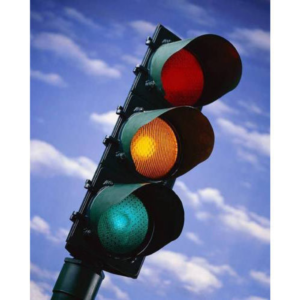
As someone who grew up in a traffic engineer’s household, I need to say that this is technically a traffic signal, and the color in the middle is “amber.”
We were at an industry conference a couple of weeks ago where we saw a lot of dashboards. Dashboards were in every presentation. Every vendor demo featured at least one. There was enough red, yellow, and green all around it sometimes felt like midtown Manhattan at rush hour.
This bothered me, and I wasn’t sure why. This is standard practice, right? What could be wrong with knowing what’s going well, what’s going badly, and what should be watched closely?
The trivial problem is that red and green are terrible choices to differentiate bad from good. Wikipedia says that 8% of men of northwestern European descent—many of our coworkers—have one of several forms of red-green color blindness. Of course, this isn’t a problem for real traffic lights, where red is always on top or on the left. But for dashboards, that’s no help.
Another problem is that color-coded dashboards tend to make us want to judge everything, whereas some things just are. Your inbound case volume may be higher than you like, but what good does it do to color that number red? While there are obviously things you can do about case volumes in the long term—better self-service, improved product quality—a red number on a dashboard is a cry for us to do something right away. Unless you’re planning on turning off the phones for a while, you can’t really affect this week’s case volumes. Or next week’s, either.
But to me, the most significant problem is that it’s easy to make dashboards a substitute for thought. Look at the dashboard, ignore the green stuff, fix (or punish) the red stuff, and ask some questions about the yellow stuff. All of us take mental shortcuts much of the time, and it seems to me that dashboards really encourage this.
For example, if I see a red number for cases closed per engineer per month, it could be that everyone’s slacking off because the World Series was on. But more likely, the explanation is more interesting. How does productivity correlate with search and reuse rates—are we not taking advantage of the knowledge we’ve gathered? How does it correlate with the complexity of new products we’ve brought to market? With recent hiring or attrition?
Or maybe, if we’re creating more knowledge, it’s a sign that self-service is working great, and our case load is getting harder on average. Or just that our customer base is growing and growing. Either explanation is great news, but you wouldn’t know it from the red number.
Measures, used well, can drive fantastic analysis and coaching conversations. Let’s just try to resist the urge to put colors on everything, especially ones that people with dichromacy can’t distinguish. Let’s take the time to understand what the numbers mean in context.
David, very thought provoking. It resonates well with me, a service professional who is often asked to share metrics and indicators like these to simplify and summarize activity. As you suggested, it might be better to spend more time looking at what’s green. Calling attention to, and doing more of what is “right” may bring greater productive results. I recall this was exactly your advice I acted on that drove our extreme satisfaction and NPS scores higher.
Too many dashboards are “True But Useless” facts, meaning those viewing them lack the ability or ambition to make improvements. I prefer “Actionable Analytics” that point the viewer toward possible root causes, if not the solution itself.